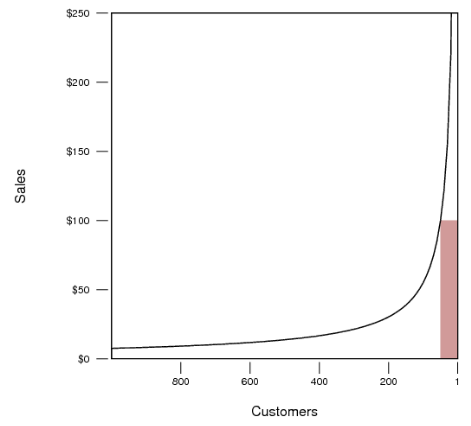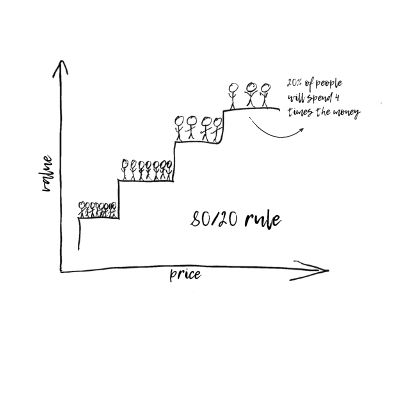
Build your value ladder and increase your CLTV
This lever is designed to maximize the value of your customer. You should never sell just one product or service at one price. Why? Because you’re leaving so much money on the table when you’re underserving your customers.
The money is in the list
If you have an audience, which could be an email list or a customer list, there is a difference in what people are willing and able to pay. If you sell only one product at one price, it means that people who want to buy from you with less budget go somewhere else. You are limiting who you can sell to. And, sometimes people just need time to warm up.
Find hidden money
Do you want to know where you’re leaving money on the table in your business? What would you be able to earn if you have one product and introduce a lower-priced and a higher-priced product?
A real-life value ladder
Chris has bought for over 20k of online courses from Ramit Sethi by being strategically guided though a value ladder.
The first course that he purchased in 2014 was called Productivity Pack. It was priced at $197 at that time. It’s a course that focuses on increasing your current productivity.
Chris bought the course and got results within two weeks. He became more productive. In other words, the value that he got was significantly higher than the price paid.
Two months later, Ramit offered a course on freelancing called Earn1k. This course promises that after completion, you can earn $1,000 per month as a freelancer. The price of this course was $997.
If you compare this to the productivity pack course, it has a higher price, but it also delivers a higher value.
The Productivity Pack course results gave Chris enough confidence that by investing in Earn1k, he would also get more value than what he paid for this course.
Chris had just started an agency and applied the principles of the Earn1K course.
Thanks to the course he was able to get that agency to a monthly revenue of 5k+ within three months.
He invested $997 to get business within three months that generated more than $5,000 per month.
At that moment in time, Ramit offers his next course, Six-Figure Consultant. The course teaches you how to get to $100,000 in revenue per year.
It’s priced at $7,500 for 12 videos and some worksheets. Investing in this was a no-brainer because Productivity Pack and Earn1k already had proved themselves.
What can you learn from this?
- Chris bought more expensive products, more comfortably each time.
- The longer his connection with Ramit, the less he focused on price and more on the value that it would generate.
- Buying his latest course at once at $7,500 would be an ask that was too big. But in this sequence, it became a no-brainer. The trust was already there.
We always tell clients to find a Trojan horse, like the cheapest course from Ramit or a free incentive, that starts a paying relationship with their customers. This incentive will show your value and allow you to sell more from that point. This concept is called a value ladder.
A value ladder is a lineup of offers that increase in price and value.
They meet people where they are on their journey to become a customer — from initial awareness to their final decision to buy your premium offerings. It’s an effective way for you to build trust and maximize the lifetime value of each customer. A great value ladder delivers so much value to the customer that they want to move up the ladder.
A value ladder increases your customer lifetime value because you’re focusing on expanding the relationship’s value. You do this by strategically placing offers and moving them through the ladder.
Types of revenue in a value ladder
An important concept to make the most out of a value ladder is front-end and back-end revenue.
- Front-end revenue = Money you make on the first sale/start of the relationship.
- Back-end revenue = Money you make on all the purchases after the first sale.
The lowest offers in your value ladder are probably the most significant source of front-end revenue. The threshold to buy is relatively low for these offers.The higher priced offers in the ladder are mostly back-end revenue. As people need warmup time first.
Many companies measure their revenue success based on front-end revenue, while top companies have more mechanisms in place to maximize back-end revenue. Building a value ladder will help you focus on generating more back-end revenue.
Let’s say that you’ve got a $100 product that you sell to 50 people per month. Every month you have 1000 visitors on your site. Perry Marshall created a tool, the 80/20 curve, to quickly show how much demand there would be for a lower-priced and a higher-priced product.

How should you read this graph that’s generated by the tool?
We have 1,000 visitors and 50 of them bought a $100 product. That’s the red area. On the vertical axis, you see the product price that people are willing to pay. On the horizontal axis, you see how many people would buy a product at that price if you would offer it.
You see that 200 people of the 1,000 would buy a $25 product. That is 200 x $25 = $5,000 of extra revenue if you try to sell this product. At the higher end, you can calculate that from this audience, 10 people would pay $400 for a higher-priced product.
Let’s calculate what the revenue potential would be: Your start revenue per month: 50 people x $100 product = $5,000
Now you’re adding a lower and a higher-priced product to this audience:
- Introduce a lower level product of $25 and 200 people will buy that = $25 x 200 = $5,000
- Introduce a higher level product of $400 and 10 people will buy that = $400 x 10 = $4,000
Total extra revenue = $9,000
By doing this, you increased your revenue from $5,000 to $14,000. That’s a 180% increase in revenue!
Perry Marshall has a handy rule of thumb for you when adding products to a value ladder:
80/20 says that 20 percent of the people will spend 4 times the money. It also says that 4 percent of the people will spend 16 times the money. Memorize this – it’s one of the most powerful facts you could ever know about business.**

Why is this a lever?
Value ladders can massively increase your revenue. It’s combining things that you already do and relationships you already have and turning that into more money. You can even automate this.
It’s a waste if you forget to serve your low-end and high-end customers by not using this strategy. You can quickly implement the first version, and you can go mega advanced, which we will show how to do. If we could go back in time, focusing on value ladders would be one of the things that we would do more.
How can you start with this now?
Download the Growth Lever Cheat Sheet and I’ll guide you through the implementation.


